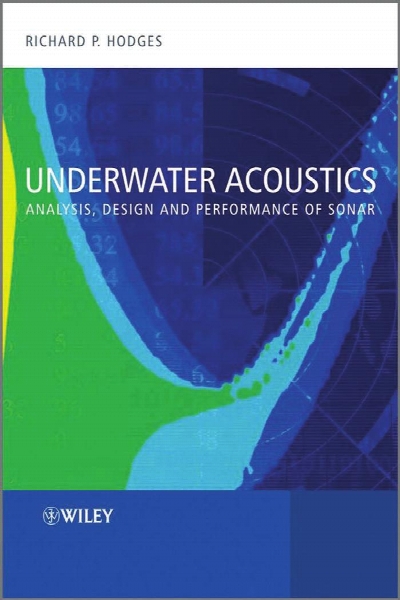Underwater acoustics : analysis, design, and performance of sonar
- نوع فایل : کتاب
- زبان : انگلیسی
- مؤلف : Richard P Hodges
- ناشر : Chichester, West Sussex [England] ; Hoboken, NJ : J. Wiley
- چاپ و سال / کشور: 2010
- شابک / ISBN : 9780470688755
Description
About the Author. Preface. Acknowledgements. 1 Introduction to Sonar. 1.1 Acoustic Waves. 1.2 Speed of Propagation. 1.3 Acoustic Wave Parameters. 1.4 Doppler Shift. 1.5 Intensity, SPL, and Decibels. 1.6 Combining Acoustic Waves. 1.7 Comparative Parameter for Sound in Water and Air. References. 2 The Sonar Equations. 2.1 Signal-to-Noise Ratio. 2.2 Active Sonar Equation. 2.3 Signal Excess. 2.4 Figure of Merit. References. 3 Transducers, Directionality, and Arrays. 3.1 Transducer Response. 3.2 Beam Pattern Response. 3.3 Linear Arrays. 3.4 Rectangular Planar Array. 3.5 Amplitude Shading. 3.6 Continuous Arrays. 3.7 Volumetric Arrays. 3.8 Product Theorem. 3.9 Broadband Beam Patterns. 3.10 Directivity and Array Gain. 3.11 Noise Cross-Correlation between Hydrophones. 3.12 Directivity of Line Arrays. 3.13 Directivity of Area Arrays. 3.14 Directivity of Volumetric Arrays. 3.15 Difference Arrays. 3.16 Multiplicative Arrays. 3.17 Sparsely Populated Arrays. 3.18 Adaptive Beamforming. References. 4 Active Sonar Sources. 4.1 Source Level. 4.2 Cavitation. 4.3 Near-Field Interactions. 4.4 Explosive Sources. 4.5 Physics of Shock Waves in Water. 4.6 Bubble Pulses. 4.7 Pros and Cons of Explosive Charges. 4.8 Parametric Acoustic Sources. References. 5 Transmission Loss. 5.1 Sound Speed Profile in the Sea. 5.2 Snell's Law and Transmission across an Interface. 5.3 Reflection and Transmission Coefficients. 5.4 Transmission through a Plate. 5.5 Ray Tracing. 5.6 Spreading Loss. 5.7 Absorption of Sound in the Ocean. References. 6 Transmission Loss: Interaction with Boundaries. 6.1 Sea State, Wind Speed, and Wave Height. 6.2 PiersonA-Moskowitz Model for Fully Developed Seas. 6.3 Sea Surface Interaction. 6.4 Bottom Loss. 6.5 Leakage Out of a Duct, Low-Frequency Cutoff. 6.6 Propagation Loss Model Descriptions. References. 7 Ambient Noise. 7.1 Ambient Noise Models. 7.2 Seismic Noise. 7.3 Ocean Turbulence. 7.4 Shipping Noise. 7.5 Wave Noise. 7.6 Thermal Noise. 7.7 Rain Noise. 7.8 Temporal Variability of Ambient Noise. 7.9 Depth Effects on Noise. 7.10 Directionality of Noise. 7.11 Under Ice Noise. 7.12 Spatial Coherence of Ambient Noise. References. 8 Reverberation. 8.1 Scattering, Backscattering Strength, and Target Strength. 8.2 Reverberation Frequency Spread and Doppler Gain Potential. 8.3 Important Observation with Respect to Reverberation. References. 9 Active Target Strength. 9.1 Target Strength Definition. 9.2 Active Target Strength of a Large Sphere. 9.3 Active Target Strength of a Very Small Sphere. 9.4 Target Strengths of Simple Geometric Forms. 9.5 Target Strength of Submarines. 9.6 The TAP Model. 9.7 Target Strength of Surface Ships. 9.8 Target Strength of Mines and Torpedoes. 9.9 Target Strength of Fish. References. 10 Radiated Noise. 10.1 General Characteristics of Ship Radiated Noise. 10.2 Propeller Radiated Noise. 10.3 Machinery Noise. 10.4 Resonance Noise. 10.5 Hydrodynamic Noise. 10.6 Platform Quieting. 10.7 Total Radiated Noise. Reference. 11 Self Noise. 11.1 Flow Noise. 11.2 Turbulent Noise Coherence. 11.3 Strumming Noise. References. 12 Statistical Detection Theory. 12.1 Introduction. 12.2 Case 1: Signal Is Known Exactly. 12.3 Case 2: Signal Is White Gaussian Noise. References. 13 Methodology for Calculation of the Recognition Differential. 13.1 Continuous Broadband Signals (PBB). 13.2 Continuous Narrowband Signals (PNB). 13.3 Active Sonar. 13.4 Aural Detection. 13.5 Display Nomenclature. References. 14 False Alarms, False Contacts, and False Targets. 14.1 Sea Story. 14.2 Failure to Detect. 14.3 Detection Theory. 14.4 False Alarm Probability Calculation. 14.5 False/Nonthreat Contacts. 14.6 False Targets. 14.7 Summary and Conclusions. References. 15 Variability and Uncertainty. 15.1 Random Variability of a Sonar. 15.2 Sources of Variability. References. 16 Modeling Detection and Tactical Decision Aids. 16.1 Figure of Merit Range or R50 %. 16.2 Tactical Decision Aids. References. 17 Cumulative Probability of Detection. 17.1 Why is CPD Important? 17.2 Discrete Glimpse and Continuous Looking. 17.3 LambdaA-Sigma Jump Model. 17.4 Nonjump Processes. 17.5 What Are Appropriate Random Parameters? 17.6 Approximation Method for Computation of the Cumulative Probability of Detection (CPD). References. 18 Tracking, Target Motion Analysis, and Localization. 18.1 Bearing Trackers. 18.2 General Principle of Tracking and Bearing Measurement. 18.3 Other Sources of Bearing Error for Area Arrays. 18.4 Additional Sources of Errors for Line Arrays. 18.5 Bottom Bounce. 18.6 Manual versus Automatic Tracking. 18.7 Localization and Target Motion Analysis. 18.8 Bearings Only Methodologies. 18.9 Four-Bearing TMA. 18.10 Ekelund Ranging. 18.11 Range and Bearing TMA. 18.12 Other Bearings Only TMA Methodologies. 18.13 Other TMA and Localization Schemes. References. 19 Design and Evaluation of Sonars. 19.1 Choice of Frequency and Size. 19.2 Computational Requirements. 19.3 Signal Processing after Beamformer. 19.4 Active Pulse Choice. 19.5 Monostatic, Bistatic, and Multistatic Active Sonars. 19.6 Ambiguity Functions. 19.7 Mine Hunting and Bottom Survey Sonars. 19.8 Echo Sounding and Fishing Sonars. 19.9 Navigation. 19.10 Vehicle Location and At-Sea Rescue. 19.11 Intercept Receivers. 19.12 Communications. 19.13 Marine Mammals and Active Sonar. References. A Fourier Transforms. A.1 Definitions. A.2 Parseval's Theorem and Plancherel's Theorem. A.3 Properties of Fourier Transforms. A.4 Localization or Uncertainty Property. B Analysis of Errors Associated with a Least Squares Methodology. Reference. Index.
Offering complete and comprehensive coverage of modern sonar spectrum system analysis, Underwater Acoustics: Analysis, Design and Performance of Sonar provides a state-of-the-art introduction to the subject and has been carefully structured to offer a much-needed update to the classic text by Urick.


